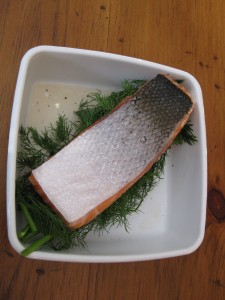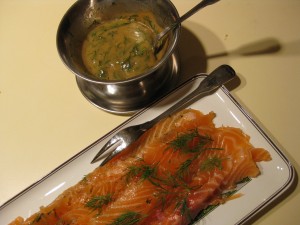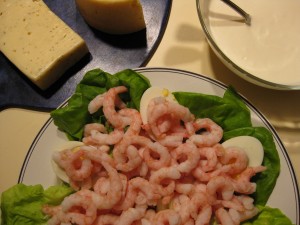By far my most popular post ever is the one to my bullar, which I linked in the previous post. I thought I would continue the Swedish Christmas season theme by giving you our recipe for gravad lax — salmon cured with dill — that we eat on Christmas Eve. Our cousins laugh at us and say that gravad lax is not appropriate for Christmas Eve but we just think they’re jealous. Begin a couple of days before you want to eat, so the evening of the 22nd for Christmas Eve.
You will need:
- As large a piece of salmon filet as you want to eat, cut in two equal sized pieces
- Equal parts sugar and salt (kosher is nice but we don’t bother). You can use 1/4 cup of each.
- white or black peppercorns, ground. for 1/4 cup sugar and salt, use 2 tablespoons of pepper.
- a massive bunch of dill
Mix the sugar, salt, and pepper together. Place half the fish, skin side down in a glass or enamel or non-reactive metal baking dish. Sprinkle some of the sugar/salt mixture over it.
“Lucy, how much is ‘some’?”
I was afraid you’d ask me that. It depends on the size of your fish. Not so it is a thick white layer. Just so much that there is a nice sprinkling. About as much as the sugar/cinnamon mixture you sprinkled over the bullar, how’s that? If you use the full 1/4 c of sugar/salt proportions, you won’t come close to finishing the mixture, unless you have a massive piece of fish. Put most of the dill layered over the salmon. Sprinkle more sugar/salt on the dill, about the same amount as before. Put the other piece of salmon on top, skin side up. It will look remarkably like this:

Put saran wrap over it, or put it into a clean plastic bag. Put the salmon in the fridge and weight it down with all those heavy condiment jars you keep in your fridge and can’t bear to throw away. Now you know why they are there. Or use a big can of tomatoes, or something heavy.
Every twelve hours or so, turn the salmon over, and then put back the weights. You will find that a little juice collects in the bottom of the dish. Great battles are fought in our family over whether you are supposed to pour off the juice, or whether you are supposed to leave it in. I forget which one we do right now, but I’m sure we’re right.
When you’re ready to eat, remove the weight, lift off the first salmon piece, gentle remove any clinging dill and sugar/salt, and slice thinly. Sprinkle with a little fresh dill and serve with mustard sauce.
Oh wait, you want the mustard sauce recipe too? To be perfectly honest, the one they sell in a jar at IKEA is perfectly acceptable, but if you can’t make it to an IKEA, you can whisk together:
- 4tbs mustard. Not Dijon. Not something grainy and German. The Swedish mustard from IKEA would have been perfect, but if you could have bought that, you could have bought the dill sauce. Oh well. Next year.
- 1 tbs. powdered mustard
- 3 tbs sugar
- 2 tbs. white vinegar
- 1/3 cup vegetable oil
- massive amounts of dill. This is why you didn’t use it all in the salmon.
Let it sit in the fridge for a bit so the tastes all marry. The whole thing should come out looking a bit like this:





